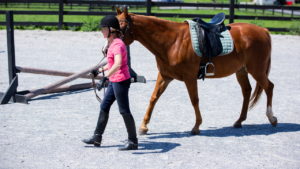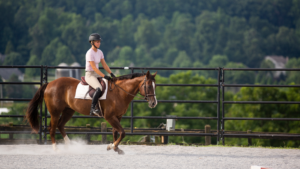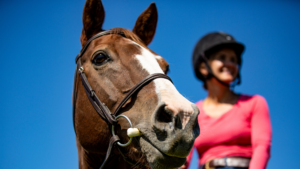No matter which continent you live on, there is likely a time of year or a type of weather that leaves you with poor footing for riding.
Whether that is slick mud, heavy snow, slippery ice, or deep sand, poor footing can be straining, tiring, and even dangerous for our horses.
In this video, I’ll share how I made decisions about what kind of footing I will (and won’t) ride in, plus how to modify your ride to be safe and still work on you and your horse’s skills.
Watch the video below and then leave a comment with the type of poor footing you and your horse have to contend with most often!
See you in the comments,
Callie
p.s. Those poor footing days can be excellent opportunities to practice unmounted exercises or many of the beginner exercises that can be done at a walk or slow trot from my book, Stay in the Saddle. Check it out here.














47 Responses
I live in Owasso, Ok. We struggle with soggy and ground mostly on our land.
Wet but hopefully you don’t deal with much freezing weather!
-Julia, HorseClass Community Manager
So I’m not alone! Here is Western MA probably the worst footing is ice. But slippery, wet grass is pretty bad too. Thanks for addressing this. We don’t all live in FL after all!
Couldn’t be more true Paula! We don’t all live in Florida or get the chance to go there for the winter.
-Julia, HorseClass Community Manager
I live in northern Ca near the foothills of the Sierras, which are clay with hard quartz extrusions. The clay is slippery when wet, holds the water a long time, riding too soon after a rain is very hard on the trails. in the summer the clay dries to a hard cement like surface Nd on multiple use trails the bikes have formed grooves where is is hard to find a flat surface wide enough for a hoof. lLots of trenches are formed from overuse and horses can fall and get stuck in the trenches.
Clay can definitely get slippery Marianne!
-Julia, HorseClass Community Manager
I have year around bad footing. When I changed barns, one with an indoor arena, I thought every thing would be great. Turns out the footing in there is very thick and heavy. My horse gets sore I. His chest area between his front legs every time we ride in there. The other option is to ride the road around the farm which is very hard. The outdoor Arena hasn’t been fixed yet. I am very frustrated. The really nice thing is that my horse has a very large paddock where we can do trick training.
Listening to your horse is such a key component, they will tell you if the footing isn’t ideal 🙂
-Julia, HorseClass Community Manager
Our situation in Northern CT is similar to yours. We have clay soil which gets very slippery, which has been most of this winter. Our arena and round pen have sand which is great but has been covered in snow most of this year. This winter has been challenging but we did get in a lot of grooming and bonding time together. I would rather not ride and be safe so when Spring, summer and fall come we can enjoy it.
I’m in Ontario and my worst footing for where I live is deep mud until early June.
Deep mud, or any kind of deep footing can be really hard on a horse’s soft tissue in their legs!
-Julia, HorseClass Community Manager
Footing! This winter we in southern CT have had a good deal of snow! I have my farrier add winter shoes with snow pads because, even if I am not riding, the hill to and from the turnouts is often slippery from refreezing. Better safe than sorry!
Im in rural northeastern Wyoming where we get winter from October through June. We get a lot of ice, snow, and mud. I feel like the worst is the mud. We have a lot of bentonite and shale which makes for a VERY slick mud that also bogs you down and clings making feet heavy and slippery. My laid back FriesianX is super easy on any surface, he is cautious, pays attention, and isn’t reactive. My Andalusian stud is always in a hurry, more reactive, and definitely unaware of his footing… he’s been an arena horse… so Im much more hesitant to work with him outside unless conditions are perfect.
Dianna, depending on the horse’s experience it can definitely affect their comfort level.
-Julia, HorseClass Community Manager
Mud! In North Carolina we have had copious amounts of rain the whole winter which has turned my outside riding arena into slop! Even after it had dried up some last week, it still was slippery. Having to take it very easy with my gaited horse who at times can be a little hot. Worked on walk (which he really needs) and some behavior issues he has decided to exhibit! Really has hampered my training sessions.
Hi Sue, that is a great plan for taking things to a slower date!
-Julia, HorseClass Community Manager
Canada, snow and ice and mud.
Can be very tricky!
Not very often but flooding, recently Sapphire in Queensland we were flooded. The aftermath is the mud sitting on our outside arena which was sand. The paddocks are also slippery with mud. I male a decision on the day as to what I will do.
Living around the corner from you, I agree with the worst footing you mentioned.
Sometimes if it rains hard and then freezes every single hoof print in the outdoor sand ring is filled with ice making the outdoor ring unusable.
I also don’t like deep mud where you suddenly find your horse knee deep. That’s scary – if they panic they could get badly injured.
Northern Florida has a mix of Georgia red clay and sand. The arena’s all have areas that are uneven where the mixture is deeper and often lower creating a pit to rise out of. This is troublesome for the health of the horse because of the risk of bowing tendons or ripping them all together, or pulled muscles. I would have to say that the round pens are the most dangerous and I usually avoid them until dragged. The main arena problem areas can simply be avoided all together.
Maine has gooey sucking mud before spring finally arrives about 3 weeks from now. Changes of frost leaving the ground make for both hard and collapsing soils beneath hooves which can be unsettling for both horse and rider.
I’m in Fl and riding on a white sand with a base of cement
It is horrible for the horses who would put down cement and then cover it with a lot of beach sand
Well i want to fix it but would like to hear what you would say needs to be done
The only thing I can’t do is remove the cement base.
Sincerely
Here in northern Colorado, our worst footing is slick clay mud which occurs when we get rain or snow that then melts
Hi Callie, I live in Switzerland and we have a lot of cold weather. Frozen ground and as you mentioned when during the day it gets a bit warmer from the sun it is muddy and slippery. In adition were I live you always have to cross a paved street with lots of traffic what I really don’t like and feel anxious. Thanks for your videos dear Callie. Greetings Vera
I do a lot of trail riding in Tennessee and lots of step hills that we are going down. My horse has to choose his footing very carefully. Lots of rocky areas too.
We have a lot of clay in our soil and when it thaws it’s like walking on grease as we slid down the mountains. No flat spots and no indoor arena. 😢 So I don’t ride all winter and when it rains.
Hi Callie, great video. I live in British Columbia Canada, in what is called the Pacific Northwest. This area is a called a rainforest for a very good reason. Rain! The worst footing would have been the outdoor hogfuel arena in the fall and winter rains. It would be very deep and was quite a workout for the horses. Luckily the owner of the stable put lots of dump trucks of new hogfuel on the arena so this winter, even with all our rain, the drainage was great and although still spongy, not as deep as previously. Thanks for the videos!
I live in the Perth hills, Western Australia. Our typical footing is rock/gravel. Our horses need to be shod continually to protect their hooves from chips, cracks and stone bruises.The gravel areas can also be quite slippery under foot.
Hi Callie.
I live in North Yorkshire in the UK .
We have a lot of rain over the winter months so most of the time we deal with riding in the rain and wind and in very muddy deep ground that makes it really hard for my arthritic Horse , we do have an Arena but my horse prefers Trail riding so most of the winter is spent riding on the roads and lanes so again not easy when we get the ice and snow , we just adapt our rides to the ever changing wether conditions and look forward to the spring/summer months.
Olive just below you in Maryland. I agree with you on the frozen with slick mud on top.if to n shady spot all frozen then hit sunny spot and you’re in the slick stuff.
That can be the most dangerous kind of footing Kitt!
-Julia, HorseClass Community Manager
I’m in the UK. We have steep narrow lanes so ice is our main one, lucky to have an arena on those days. Also flint is a problem so if I can’t get his boots on we pick a different route. Harsh weather can change the footing too so flexibility is key.
You’ve got that so right Claire, sometimes the weather makes us need to adjust our expectations for the ride!
-Julia, HorseClass Community Manager
We rarely have snow but we do have wet, slippery mud.
Mud can be equality dangerous!
-Julia, HorseClass Community Manager
I live in Bremen, Northern Germany. We have usually quite mild winters with only a little snow, but a lot of rain = mud = working in walk, groundwork etc. The worst conditions result from common weather changes,from some degrees below zero to rainy, then the ground gets very icy and slippery. In that case, only indoors is safe.
Where I live in western Washington, the worst footing is the wet slippery clay found on many of the trails. We have access to some very nice trails we it’s lots of hills but this can be treacherous during our rainy months.
Thanks for the videos, you do a great job.
Glad you enjoy the videos Connie!
-Julia, HorseClass Community Manager
Hi Callie, I live in Ireland. The school arena is poorly drained so if there’s been heavy rain, the sand gets soft and sloppy with lots of puddles.
Hi Leona, I can totally relate! It can be really tough to only have a grass arena in this kind of weather.
-Julia, HorseClass Community Manager
Here in Northern Ontario the most difficult time to assess riding on the trails. The snow has iced areas in the shaded areas and wet slippery melting areas in the sun. Under the snow in many trail areas are smoothed rock surfaces or pot holes. I only ride the trails I am familiar with and always with a partner rider in case of trail issues.
Iowa, freezing rain leaving icy conditions during much of the winter. The spring is deep mud/sloppy conditions where the horse slips a lot.
Hi Callie,
I do a lot of riding at our place in Minnesota on anything from winter snow to spring rain and mud and my 20 yr old quarter horse does fine barefoot. I also do trail riding in Minnesota in the summer with lots of steep hills that we are going up and down. My horse has to choose his footing very carefully and does very well. Lots of rocky areas too and the roadways at the park that we ride at has very sharp stones and his hooves seem very sensitive. I have Cavallo hoof boots for his front hooves but he still seems very sensitive on those sharp stones even when he has the Cavallo hoof boots on. He walks very slow and tries to get to the side of the road where there is grass. I worry about having his Cavallo Hoof Boots on at the park as this is where we are riding in the river, on steep hills that we are going up and down, the sharp rocks on the roadways and other variables as well. I then wonder if I should get Cavallo hoof boots for his back feet as well. He only had 1 previous owner which brought him trail riding in Montana. I do not know if he always shoed him but I want him to be barefoot. We have put pine tar on his hooves twice now this spring to prevent hoof abscesses and hopefully harden his soles and frogs. We are going to this same park on memorial day weekend 2021. What do you suggest? Do I get the another pair of Cavallo Hoof Boots? Is the pine tar really going to help with his sensitivity? Do I need to have him shoed? I am fairly new to riding and to horses in general (3 years) but have learned a lot and am doing well. Thank you so much for your videos that have taught me so much. You are awesome!!
Have you brought the sensitivity up to your vet or farrier?
-Julia, HorseClass Community Manager
His farrier thinks he is just not used to the sensation of the rocks.
Some horses are very sensitive in certain kinds of footing Becky!
-Julia, HorseClass Community Manager
Thank you for addressing the important topic of riding on a poor footing in your post. It’s crucial for riders to understand the challenges and potential risks that come with navigating uneven or unstable surfaces.
Your tips on maintaining balance, adjusting riding techniques, and being mindful of the horse’s well-being are extremely helpful. In addition to these considerations, I would like to highlight the potential benefits of using a calming supplement for horses when riding on poor footing.
Calming supplements can provide an extra layer of support for horses during challenging riding conditions. They are specifically formulated to help horses manage stress and anxiety, which can arise from unfamiliar or difficult terrain. By promoting relaxation and focus, these supplements can help horses maintain a calm demeanor and make informed decisions while navigating challenging footing.
It would be interesting to hear your perspective on the use of calming supplement for horse in such situations. Do you believe they can play a role in enhancing the horse’s comfort and confidence when riding on poor footing? Have you had any personal experiences or success stories with the use of these supplements in challenging riding conditions?